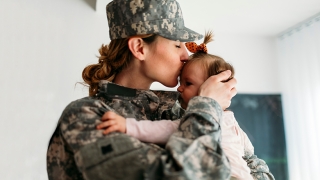Military Matters: Align Paid Family Leave With FMLA

PFL for military exigency leave follows FMLA definitions.
Qualifying exigency leave under the FMLA helps employees manage family affairs when their family members are called to or on covered active duty.
When can an employee take military-related Paid Family Leave? New York's regulations don't say much about this category. Instead, the rules simply state that “military-exigency” benefits follow the Family and Medical Leave Act definitions. In other words, PFL uses the FMLA as the foundation for military exigency leaves.
Here's a closer look at who's eligible and what situations qualify, including a chart with examples.
When can employees take military-related Paid Family Leave?
An employee may take paid time off to take care of family matters if a family member:
- Is on active duty,
- Is called to active duty status, or
- Has received notice of an impending call to active duty in the armed forces of the United States
What does 'active duty' mean?
If a qualified family member is in the regular armed forces, the definition means duty with the armed forces of the United States during deployment to a foreign country.
If a qualified family member is in a reserve component of the Armed Forces, the definition applies during deployment to a foreign country under a call or order to active duty in support of a contingency operation.
Who qualifies as a family member?
A qualified family member called to active duty includes:
- Spouse
- Domestic partner
- Child
- Parent — includes biological, foster or adoptive parents, stepparents and in-laws, as well as a legal guardian (or other person who stood “in loco parentis,” a Latin phrase meaning “in place of a parent,” to the employee when the employee was a child)
PFL regulations don't go into detail about military leave. What else do I need to know?
New York State used the FMLA as the foundation for military-related Paid Family Leave. The regulations simply state that PFL benefits “are based upon a qualifying exigency as interpreted under the Family and Medical Leave Act, 29 U.S.C.S 2612(a)(1)(e) and 29 C.F.R. 825.126(b)(1)–(9).”
To explore specific examples, refer to the chart below. Remember: Any changes to FMLA rules and definitions will also apply to PFL.
My group has fewer than 50 employees. Do I have to coordinate military-related PFL with FMLA?
Employers who aren't subject to FMLA won't have to coordinate PFL with FMLA. Just review the definitions in case you have any employees with family members in the military.
How much paid time off can employees take for a qualifying military need under PFL?
Overall, employees may take the same maximum benefit length and amount as for other PFL-qualifying events. However, some specific exigencies have their own maximum durations, based on underlying FMLA definitions.
What military-related family needs fit the definition of a “qualifying exigency?”
The chart below lists current FMLA definitions, also found under FMLA regulations 29 C.F.R. § 825.126.
| Qualifying Exigency | Definition and Examples |
|---|---|
| Deployments with notice of 7 days or less | To address issues arising from the short notice Maximum duration: Up to 7 calendar days (beginning on the day the military member receives the notice) |
| Financial and legal arrangements | Examples include but aren't limited to:
|
| Counseling | To cope with the psychological stress of the family member's deployment (for counseling services provided by someone other than a health-care provider) |
| Military events and related activities | Examples include:
|
| Child care and school activities | What may qualify: Care for the military member's child that's needed because of the member's active duty Examples include: arranging for alternative child care, providing non-routine, urgent/immediate child care, school or day care enrollment/transfer and attending pertinent school or day care meetings What doesn't qualify: Taking leave to perform ongoing, everyday child care (i.e., becoming the primary caregiver during the deployment) or attending routine school events (such as parties or plays) The employee taking paid leave doesn't need to be directly related to the military member's child. The children of the employee's spouse, child and parent called to/on active duty also qualify. |
| Parental care | For the military member's parent who is incapable of self-care Examples include:
|
| Rest and Recuperation leave | To spend time with the family member who is on R&R — Rest and Recuperation leave — during covered active duty Maximum duration: Up to 15 calendar days |
| Post-deployment activities | Examples include:
|
| Additional service-related activities | Any other event that the employer accepts as a qualifying exigency and agrees to the leave's timing and duration |
For more details, visit: ny.gov/programs/new-york-state-paid-family-leave.
Follow The Standard on Facebook, LinkedIn and Twitter with the hashtag #PaidFamilyLeave, and subscribe to this blog's RSS feed to receive updated content as new information becomes available.
More About Paid Family Leave Administration








